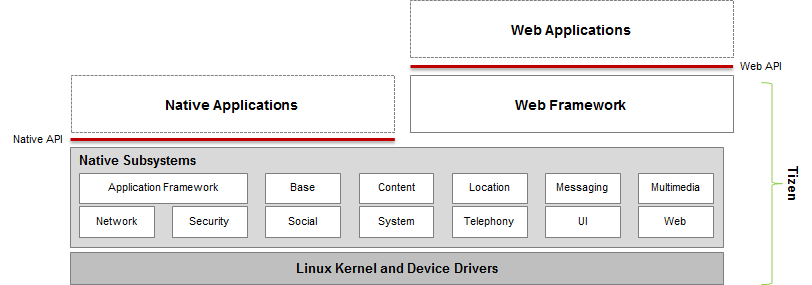Understanding Tizen Programming
When designing Tizen Web applications, you need to take into account the following programming concepts:
- Tizen APIs
- Security and API Privileges
- Application Filtering
- Web Runtime
- Event Handling (in wearable applications only)
Tizen Platform Introduction
Tizen is a user-interactive and service-oriented open-source project that allows you to create feature-rich applications for multiple device categories, such as smartphones, tablets and wearable devices (for example, smartwatches), using various APIs. The Tizen platform allows you to create a wide range of applications for Tizen devices, customized with the common Tizen architecture as its basis. Tizen also provides Web sites with tools for creating, distributing, and managing applications efficiently.
The Tizen platform supports 2 different application types: the Web application and the native application. The Tizen platform also allows you to develop a hybrid application package where Web and native applications are packaged together to make more powerful applications. The Tizen platform ensures that all Tizen applications have consistent look and feel, regardless of whether you are creating a Web or native application.
The Tizen platform provides various profiles for application development: the mobile and wearable Web profiles can be used to develop Web applications for mobile and wearable devices, while the mobile native profile can be used to develop native applications for mobile devices.
Tizen Architecture
Tizen is a standards-based platform that provides Web and native APIs for developing applications for multiple device categories. Tizen is currently targeted for smart phones, tablet devices (mobile profile), and wearable devices (wearable profile), though planned to cover more device categories in the future. The following figure illustrates the Tizen architecture.
Figure: Tizen architecture

The Tizen architecture consists of the following subsystems:
- Web framework
The Web framework accommodates and leverages most up-to-date Web technologies. It provides a large number of HTML5 functionalities defined by W3C and other standardization groups, such as video, audio, form, 2D canvas, WebGL, CSS3, geolocation, vibration, Web socket, and Web worker. In addition, the framework defines various new device APIs, which enable you to access device functionalities, such as Bluetooth, near field communication (NFC), alarm, and messaging. The device functionalities are provided with a strict rule-based security control system that restricts the malicious use of the device APIs.
- Native framework
The native framework is composed of system services and a set of native modules across various domains, with which native applications can be developed. The modules include, for example, Base, Application framework, Security, UI, Network, Messaging, Social, Locations, and Web. The framework also provides popular standard open source libraries, such as eglibc, libstdc++, libxml2, OpenAL, and OpenMP®, to support efficient application development and the migration of pre-existing applications using such libraries.
Note Only a selected set of APIs in the native framework are native APIs. This means that native applications must use the listed native APIs in the API Reference which are managed by API maintainers in the Tizen project. - Kernel
The kernel layer contains the Linux kernel and device drivers.


